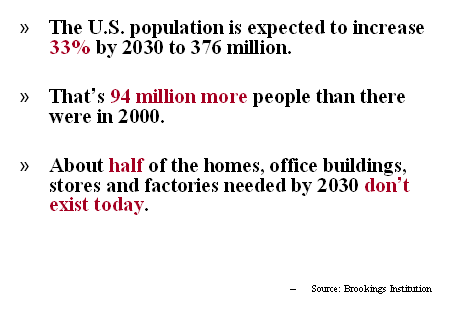I agree that housing will be in a dire situation sooner than we can imagine. As one of the aging baby boomers thinking of down sizing my home, I have pondered alternatives instead. I have a 6 bedroom home with two kitchens, one being a "summer" kitchen, that is without an oven, but with all the other amenities. I could sell my home and move into a smaller abode, or start something different and new. The six bedrooms could house 12 people quite comfortably. Baby boomers are often single and lonely as time moves on, and the idea of sharing the home with other capable and able people is very appealing. There is a beautiful garden and a stellar ocean view. Not many people have the luxury of living in such a home, so why not find a way to share it. The trouble is that we are zoned single family and the city would not allow this to happen. By sharing the home, the energy use would be reduced greatly as opposed to those 12 individuals living in separate condos. A certain autonomy is maintained as they are totally self governed. Perhaps we should be looking more closely at alternative, instead of planning to create new homes for everyone. How do we get the city to cooperate and is it a good idea?
Blog Post
About half of the homes, office buildings, stores and factories needed by 2030 don't exist today.
So says the Urban Land Institute. The following grabs are from a couple slides in A Plan for Tomorrow: Creating Stronger and Healthier Communities Today and the nearly identical A Plan for Tomorrow: Creating Stronger and Healthier Cities Today, companion PowerPoint presentations to Higher Density Development: Myth and Fact.


"Greenhouse gas emissions are increasing, and the U.S. carbon footprint is expanding. Since 1980, carbon emissions in the United States have increased by almost 1 percent each year. Emissions from the residential, commercial, and transportation sectors each increased by more than 25 percent during the past 25 years. Industrial emissions have declined during this same period as the country has moved away from energy-intensive manufacturing and toward a service and knowledge economy. Much of what Americans once manufactured is now being imported from China, India, and other countries, thereby lessening U.S. greenhouse gas accounts. "As a result, consumers are increasingly the driving force of domestic energy consumption and carbon emissions. Residential and commercial buildings and road transportation are expected to dominate energy demand and carbon growth in the future. Total U.S. carbon emissions are projected to grow by 16 percent between 2006 and 2030..."From Shrinking the Carbon Footprint of Metropolitan America, a report from the Brookings Institution.
Published June 3, 2008 Permalink Citation
(2008, June 3). About half of the homes, office buildings, stores and factories needed by 2030 don't exist today.. Retrieved from https://www.buildinggreen.com/blog/about-half-homes-office-buildings-stores-and-factories-needed-2030-dont-exist-today



Add new comment
To post a comment, you need to register for a BuildingGreen Basic membership (free) or login to your existing profile.